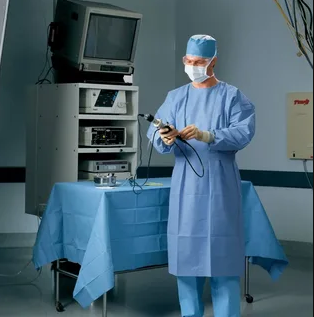
Are Surgical Gown Scrubs Essential for Healthcare Professionals
Surgical gowns, or scrubs as they are commonly known, can stop healthcare professionals from spreading germs from one patient to another. They are a critical component of personal protective equipment (PPE). The gowns should be durable and made from materials that won’t bind or constrict the doctor wearing them.
Surgical Gown Scrub
Surgical Gown Scrub create a barrier between the germs that are on the hands of the doctor or surgeon and the patients. They also help keep blood and bodily fluids from spraying onto the medical staff, as well as the equipment in the sterile operating theater (OT). To protect the doctors, nurses, and surgeons in a clean and safe environment, it is important to put on and remove the gowns correctly. This is where scrubs come in.
Scrubs evolved from traditional medical uniforms in the 1940s, when advances in healthcare practices made it necessary to have a sterile environment for operations. Initially, surgical clothing was white to emphasize cleanliness but bright operating lights combined with white garments created eye strain for the medical team. As a result, the scrub colors were changed from white to darker shades in order to reduce eyestrain. Then in the 1980s, new rules were introduced to minimize the risk of exposure to blood-borne pathogens.
As a result, a unisex two-piece outfit was developed consisting of a short-sleeve V-necked shirt and drawstring pants. These could be washed at high temperatures for sterilisation and were comfortable to wear. These were topped by a tie-back or bouffant-style cloth cap to cover the hair, a gauze or synthetic textile mask, and latex gloves and supportive closed-toe shoes. Known as scrubs, the uniforms came to be worn by all medical professionals on duty.
Surgical Gown
Surgical gowns are a type of personal protective equipment (PPE) worn by healthcare workers during patient-care related procedures. They protect the health care professional from the transfer of microorganisms and body fluids between patients and healthcare staff. Surgical gowns are also important for protecting the health care professional from pathogen penetration and contamination of critical areas. The CDC recommends that healthcare workers wear these garments as part of their PPE during invasive procedures to minimize exposure to blood, bodily fluids, and other potentially infectious materials.
The most important feature of a surgical gown is its barrier properties. The gown should be impermeable, breathable and prevent the penetration of microorganisms or body fluids from one body area to another. It should also have an antistatic property and be able to wick away moisture from the skin. In addition, the fabric should be comfortable and durable.
In the past, surgical gowns were made from cotton muslin or polyester. Currently, reusable and disposable surgical gowns are available in many different fabrics. The choice of fabric depends on the procedure being performed, the operating environment, and the duration of the operation. For example, a high-risk surgery with a lot of bleeding would require a higher level of barrier performance than a low-risk procedure. The cuffs on the sleeves of a surgical gown can be elastic or made from a knit material. Typically, the cuffs have thumb loops to help the user pull their gloves up easily and stay in place during the procedure.
Surgical Gown Australia
Surgical Gown Australia, along with gloves and face masks, are personal protective equipment (PPE) that minimize the transmission of viruses to patients and the exposure of healthcare professionals to blood-borne pathogens. They should be comfortable, durable and provide effective barrier protection to the skin. They should also be resistant to tears, punctures and abrasions. Several professional guidelines are available to help healthcare workers make appropriate selections of surgical gowns, such as those from the Association of periOperative Registered Nurses (AORN).
To maximize the barrier performance and comfort of the surgical gowns, manufacturers add various materials in the form of coatings, reinforcements, or laminates. These materials can be added to woven or nonwoven polypropylene fabric to improve the liquid-repellent properties of the garment, to increase its breathability, or to improve its abrasion resistance and slip resistance.
The abrasion resistance of the surgical gowns depends on the type and amount of fiber used in the fabric. The more fibers a garment has, the higher its abrasion resistance. The lint-freeness of the garment is also important. Lint particles can cause tissue damage and infection, and should be kept to a minimum. In addition to being lint-free, the barrier materials used in surgical gowns should be resistant to bacteria.
Surgical Gown Melbourne
Hospital gowns are used by healthcare professionals to protect themselves from the transfer of bodily fluids and microorganisms during surgical procedures and other medical treatments. They are available in both disposable and reusable versions. Surgical gowns have barrier qualities, low particle release rates, and high purity levels, making them the preferred option for high-risk surgeries. They are also available in different levels of protection, from basic to advanced. In addition to protecting healthcare workers, these gowns can help prevent patient infections and disease spread.
The COVID-19 pandemic created a sudden surge in demand for personal protective equipment, including hospitals gowns. This prompted multiple industries to improve their product offerings in order to meet increased customer needs. Several players in the healthcare industry are working to make hospital gowns more comfortable and durable, which is expected to drive market growth in the coming years.
Many medical facilities require their staff to wear gowns to ensure they are protected from infection. However, they aren’t always effective in preventing contamination and can be uncomfortable. That’s why it is important to choose a gown that provides a high level of protection. In addition, they must be easy to clean and sterilize.


